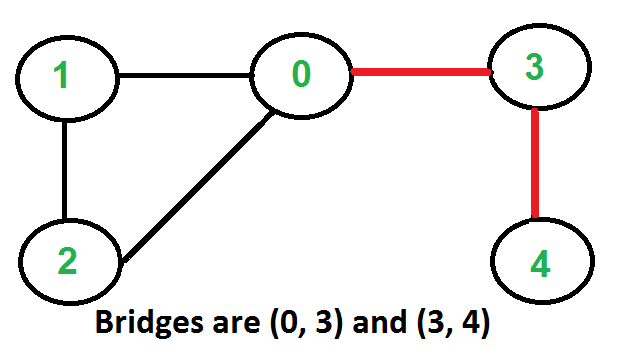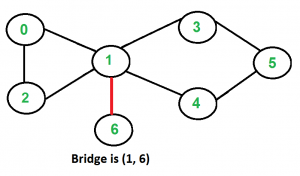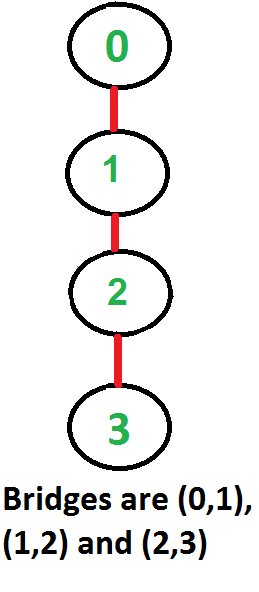本文概述
无向连通图中的一条边是断开该图的桥。对于一个断开的无向图,它的定义是类似的,桥是一个删除边缘,增加断开组件的数量。
像连接点一样,桥表示连接网络中的漏洞,对于设计可靠的网络非常有用。例如,在有线计算机网络中,一个连接点表示关键计算机,一个桥表示关键导线或连接。
以下是一些带有红色突出显示的桥的示例图。



如何找到给定图中的所有桥?
一种简单的方法是一个接一个地删除所有边, 并查看是否删除边会导致图形断开。以下是连接图的简单方法步骤。
1)对于每个边(u, v), 请执行以下操作
…..a)从图表中删除(u, v)
..…b)查看图形是否保持连接状态(我们可以使用BFS或DFS)
…..c)将(u, v)添加回图形。
对于使用邻接表表示的图, 上述方法的时间复杂度为O(E *(V + E))。我们可以做得更好吗?
O(V + E)算法查找所有桥梁
其思想类似于O(V+E)算法的衔接点。我们对给定的图做DFS遍历。在DFS树中,一条边(u, v) (u在DFS树中是v的父)是桥,如果没有任何其他的选择可以到达u或者以v为根的子树到达u的祖先。
正如前一篇文章所讨论的,low[v]表示从以v为根的子树中可以到达的最早访问的顶点。边(u, v)成为桥的条件是:“low[v] > disc[u]”。
以下是上述方法的C ++和Java实现。
C ++
// A C++ program to find bridges in a given undirected graph
#include<iostream>
#include <list>
#define NIL -1
using namespace std;
// A class that represents an undirected graph
class Graph
{
int V; // No. of vertices
list< int > *adj; // A dynamic array of adjacency lists
void bridgeUtil( int v, bool visited[], int disc[], int low[], int parent[]);
public :
Graph( int V); // Constructor
void addEdge( int v, int w); // to add an edge to graph
void bridge(); // prints all bridges
};
Graph::Graph( int V)
{
this ->V = V;
adj = new list< int >[V];
}
void Graph::addEdge( int v, int w)
{
adj[v].push_back(w);
adj[w].push_back(v); // Note: the graph is undirected
}
// A recursive function that finds and prints bridges using
// DFS traversal
// u --> The vertex to be visited next
// visited[] --> keeps tract of visited vertices
// disc[] --> Stores discovery times of visited vertices
// parent[] --> Stores parent vertices in DFS tree
void Graph::bridgeUtil( int u, bool visited[], int disc[], int low[], int parent[])
{
// A static variable is used for simplicity, we can
// avoid use of static variable by passing a pointer.
static int time = 0;
// Mark the current node as visited
visited[u] = true ;
// Initialize discovery time and low value
disc[u] = low[u] = ++ time ;
// Go through all vertices aadjacent to this
list< int >::iterator i;
for (i = adj[u].begin(); i != adj[u].end(); ++i)
{
int v = *i; // v is current adjacent of u
// If v is not visited yet, then recur for it
if (!visited[v])
{
parent[v] = u;
bridgeUtil(v, visited, disc, low, parent);
// Check if the subtree rooted with v has a
// connection to one of the ancestors of u
low[u] = min(low[u], low[v]);
// If the lowest vertex reachable from subtree
// under v is below u in DFS tree, then u-v
// is a bridge
if (low[v] > disc[u])
cout << u << " " << v << endl;
}
// Update low value of u for parent function calls.
else if (v != parent[u])
low[u] = min(low[u], disc[v]);
}
}
// DFS based function to find all bridges. It uses recursive
// function bridgeUtil()
void Graph::bridge()
{
// Mark all the vertices as not visited
bool *visited = new bool [V];
int *disc = new int [V];
int *low = new int [V];
int *parent = new int [V];
// Initialize parent and visited arrays
for ( int i = 0; i < V; i++)
{
parent[i] = NIL;
visited[i] = false ;
}
// Call the recursive helper function to find Bridges
// in DFS tree rooted with vertex 'i'
for ( int i = 0; i < V; i++)
if (visited[i] == false )
bridgeUtil(i, visited, disc, low, parent);
}
// Driver program to test above function
int main()
{
// Create graphs given in above diagrams
cout << "\nBridges in first graph \n" ;
Graph g1(5);
g1.addEdge(1, 0);
g1.addEdge(0, 2);
g1.addEdge(2, 1);
g1.addEdge(0, 3);
g1.addEdge(3, 4);
g1.bridge();
cout << "\nBridges in second graph \n" ;
Graph g2(4);
g2.addEdge(0, 1);
g2.addEdge(1, 2);
g2.addEdge(2, 3);
g2.bridge();
cout << "\nBridges in third graph \n" ;
Graph g3(7);
g3.addEdge(0, 1);
g3.addEdge(1, 2);
g3.addEdge(2, 0);
g3.addEdge(1, 3);
g3.addEdge(1, 4);
g3.addEdge(1, 6);
g3.addEdge(3, 5);
g3.addEdge(4, 5);
g3.bridge();
return 0;
}Java
// A Java program to find bridges in a given undirected graph
import java.io.*;
import java.util.*;
import java.util.LinkedList;
// This class represents a undirected graph using adjacency list
// representation
class Graph
{
private int V; // No. of vertices
// Array of lists for Adjacency List Representation
private LinkedList<Integer> adj[];
int time = 0 ;
static final int NIL = - 1 ;
// Constructor
Graph( int v)
{
V = v;
adj = new LinkedList[v];
for ( int i= 0 ; i<v; ++i)
adj[i] = new LinkedList();
}
// Function to add an edge into the graph
void addEdge( int v, int w)
{
adj[v].add(w); // Add w to v's list.
adj[w].add(v); //Add v to w's list
}
// A recursive function that finds and prints bridges
// using DFS traversal
// u --> The vertex to be visited next
// visited[] --> keeps tract of visited vertices
// disc[] --> Stores discovery times of visited vertices
// parent[] --> Stores parent vertices in DFS tree
void bridgeUtil( int u, boolean visited[], int disc[], int low[], int parent[])
{
// Mark the current node as visited
visited[u] = true ;
// Initialize discovery time and low value
disc[u] = low[u] = ++time;
// Go through all vertices aadjacent to this
Iterator<Integer> i = adj[u].iterator();
while (i.hasNext())
{
int v = i.next(); // v is current adjacent of u
// If v is not visited yet, then make it a child
// of u in DFS tree and recur for it.
// If v is not visited yet, then recur for it
if (!visited[v])
{
parent[v] = u;
bridgeUtil(v, visited, disc, low, parent);
// Check if the subtree rooted with v has a
// connection to one of the ancestors of u
low[u] = Math.min(low[u], low[v]);
// If the lowest vertex reachable from subtree
// under v is below u in DFS tree, then u-v is
// a bridge
if (low[v] > disc[u])
System.out.println(u+ " " +v);
}
// Update low value of u for parent function calls.
else if (v != parent[u])
low[u] = Math.min(low[u], disc[v]);
}
}
// DFS based function to find all bridges. It uses recursive
// function bridgeUtil()
void bridge()
{
// Mark all the vertices as not visited
boolean visited[] = new boolean [V];
int disc[] = new int [V];
int low[] = new int [V];
int parent[] = new int [V];
// Initialize parent and visited, and ap(articulation point)
// arrays
for ( int i = 0 ; i < V; i++)
{
parent[i] = NIL;
visited[i] = false ;
}
// Call the recursive helper function to find Bridges
// in DFS tree rooted with vertex 'i'
for ( int i = 0 ; i < V; i++)
if (visited[i] == false )
bridgeUtil(i, visited, disc, low, parent);
}
public static void main(String args[])
{
// Create graphs given in above diagrams
System.out.println( "Bridges in first graph " );
Graph g1 = new Graph( 5 );
g1.addEdge( 1 , 0 );
g1.addEdge( 0 , 2 );
g1.addEdge( 2 , 1 );
g1.addEdge( 0 , 3 );
g1.addEdge( 3 , 4 );
g1.bridge();
System.out.println();
System.out.println( "Bridges in Second graph" );
Graph g2 = new Graph( 4 );
g2.addEdge( 0 , 1 );
g2.addEdge( 1 , 2 );
g2.addEdge( 2 , 3 );
g2.bridge();
System.out.println();
System.out.println( "Bridges in Third graph " );
Graph g3 = new Graph( 7 );
g3.addEdge( 0 , 1 );
g3.addEdge( 1 , 2 );
g3.addEdge( 2 , 0 );
g3.addEdge( 1 , 3 );
g3.addEdge( 1 , 4 );
g3.addEdge( 1 , 6 );
g3.addEdge( 3 , 5 );
g3.addEdge( 4 , 5 );
g3.bridge();
}
}
// This code is contributed by Aakash Hasijapython
# Python program to find bridges in a given undirected graph
#Complexity : O(V+E)
from collections import defaultdict
#This class represents an undirected graph using adjacency list representation
class Graph:
def __init__( self , vertices):
self .V = vertices #No. of vertices
self .graph = defaultdict( list ) # default dictionary to store graph
self .Time = 0
# function to add an edge to graph
def addEdge( self , u, v):
self .graph[u].append(v)
self .graph[v].append(u)
'''A recursive function that finds and prints bridges
using DFS traversal
u --> The vertex to be visited next
visited[] --> keeps tract of visited vertices
disc[] --> Stores discovery times of visited vertices
parent[] --> Stores parent vertices in DFS tree'''
def bridgeUtil( self , u, visited, parent, low, disc):
# Mark the current node as visited and print it
visited[u] = True
# Initialize discovery time and low value
disc[u] = self .Time
low[u] = self .Time
self .Time + = 1
#Recur for all the vertices adjacent to this vertex
for v in self .graph[u]:
# If v is not visited yet, then make it a child of u
# in DFS tree and recur for it
if visited[v] = = False :
parent[v] = u
self .bridgeUtil(v, visited, parent, low, disc)
# Check if the subtree rooted with v has a connection to
# one of the ancestors of u
low[u] = min (low[u], low[v])
''' If the lowest vertex reachable from subtree
under v is below u in DFS tree, then u-v is
a bridge'''
if low[v] > disc[u]:
print ( "%d %d" % (u, v))
elif v ! = parent[u]: # Update low value of u for parent function calls.
low[u] = min (low[u], disc[v])
# DFS based function to find all bridges. It uses recursive
# function bridgeUtil()
def bridge( self ):
# Mark all the vertices as not visited and Initialize parent and visited, # and ap(articulation point) arrays
visited = [ False ] * ( self .V)
disc = [ float ( "Inf" )] * ( self .V)
low = [ float ( "Inf" )] * ( self .V)
parent = [ - 1 ] * ( self .V)
# Call the recursive helper function to find bridges
# in DFS tree rooted with vertex 'i'
for i in range ( self .V):
if visited[i] = = False :
self .bridgeUtil(i, visited, parent, low, disc)
# Create a graph given in the above diagram
g1 = Graph( 5 )
g1.addEdge( 1 , 0 )
g1.addEdge( 0 , 2 )
g1.addEdge( 2 , 1 )
g1.addEdge( 0 , 3 )
g1.addEdge( 3 , 4 )
print "Bridges in first graph "
g1.bridge()
g2 = Graph( 4 )
g2.addEdge( 0 , 1 )
g2.addEdge( 1 , 2 )
g2.addEdge( 2 , 3 )
print "\nBridges in second graph "
g2.bridge()
g3 = Graph ( 7 )
g3.addEdge( 0 , 1 )
g3.addEdge( 1 , 2 )
g3.addEdge( 2 , 0 )
g3.addEdge( 1 , 3 )
g3.addEdge( 1 , 4 )
g3.addEdge( 1 , 6 )
g3.addEdge( 3 , 5 )
g3.addEdge( 4 , 5 )
print "\nBridges in third graph "
g3.bridge()
#This code is contributed by Neelam YadavC#
// A C# program to find bridges
// in a given undirected graph
using System;
using System.Collections.Generic;
// This class represents a undirected graph
// using adjacency list representation
public class Graph
{
private int V; // No. of vertices
// Array of lists for Adjacency List Representation
private List< int > []adj;
int time = 0;
static readonly int NIL = -1;
// Constructor
Graph( int v)
{
V = v;
adj = new List< int >[v];
for ( int i = 0; i < v; ++i)
adj[i] = new List< int >();
}
// Function to add an edge into the graph
void addEdge( int v, int w)
{
adj[v].Add(w); // Add w to v's list.
adj[w].Add(v); //Add v to w's list
}
// A recursive function that finds and prints bridges
// using DFS traversal
// u --> The vertex to be visited next
// visited[] --> keeps tract of visited vertices
// disc[] --> Stores discovery times of visited vertices
// parent[] --> Stores parent vertices in DFS tree
void bridgeUtil( int u, bool []visited, int []disc, int []low, int []parent)
{
// Mark the current node as visited
visited[u] = true ;
// Initialize discovery time and low value
disc[u] = low[u] = ++time;
// Go through all vertices aadjacent to this
foreach ( int i in adj[u])
{
int v = i; // v is current adjacent of u
// If v is not visited yet, then make it a child
// of u in DFS tree and recur for it.
// If v is not visited yet, then recur for it
if (!visited[v])
{
parent[v] = u;
bridgeUtil(v, visited, disc, low, parent);
// Check if the subtree rooted with v has a
// connection to one of the ancestors of u
low[u] = Math.Min(low[u], low[v]);
// If the lowest vertex reachable from subtree
// under v is below u in DFS tree, then u-v is
// a bridge
if (low[v] > disc[u])
Console.WriteLine(u + " " + v);
}
// Update low value of u for parent function calls.
else if (v != parent[u])
low[u] = Math.Min(low[u], disc[v]);
}
}
// DFS based function to find all bridges. It uses recursive
// function bridgeUtil()
void bridge()
{
// Mark all the vertices as not visited
bool []visited = new bool [V];
int []disc = new int [V];
int []low = new int [V];
int []parent = new int [V];
// Initialize parent and visited, // and ap(articulation point) arrays
for ( int i = 0; i < V; i++)
{
parent[i] = NIL;
visited[i] = false ;
}
// Call the recursive helper function to find Bridges
// in DFS tree rooted with vertex 'i'
for ( int i = 0; i < V; i++)
if (visited[i] == false )
bridgeUtil(i, visited, disc, low, parent);
}
// Driver code
public static void Main(String []args)
{
// Create graphs given in above diagrams
Console.WriteLine( "Bridges in first graph " );
Graph g1 = new Graph(5);
g1.addEdge(1, 0);
g1.addEdge(0, 2);
g1.addEdge(2, 1);
g1.addEdge(0, 3);
g1.addEdge(3, 4);
g1.bridge();
Console.WriteLine();
Console.WriteLine( "Bridges in Second graph" );
Graph g2 = new Graph(4);
g2.addEdge(0, 1);
g2.addEdge(1, 2);
g2.addEdge(2, 3);
g2.bridge();
Console.WriteLine();
Console.WriteLine( "Bridges in Third graph " );
Graph g3 = new Graph(7);
g3.addEdge(0, 1);
g3.addEdge(1, 2);
g3.addEdge(2, 0);
g3.addEdge(1, 3);
g3.addEdge(1, 4);
g3.addEdge(1, 6);
g3.addEdge(3, 5);
g3.addEdge(4, 5);
g3.bridge();
}
}
// This code is contributed by Rajput-Ji输出如下:
Bridges in first graph
3 4
0 3
Bridges in second graph
2 3
1 2
0 1
Bridges in third graph
1 6时间复杂度:上面的功能是带有附加数组的简单DFS。因此, 时间复杂度与DFS相同, 对于图的邻接表表示, 它的时间复杂度为O(V + E)。
参考文献:
https://www.cs.washington.edu/education/courses/421/04su/slides/artic.pdf
http://faculty.simpson.edu/lydia.sinapova/www/cmsc250/LN250_Weiss/L25-Connectivity.htm
如果发现任何不正确的地方, 或者想分享有关上述主题的更多信息, 请写评论。

![从字法上最小长度N的排列,使得对于正好为K个索引,a[i] a[i]+1](https://www.lsbin.com/wp-content/themes/begin%20lts/img/loading.png)